Numerical Study on the Mechanical Behavior of Sand–Rubber Mixtures under True Triaxial Tests
Abstract
1. Introduction
2. Numerical Simulation Based on DEM
2.1. Rolling Resistance Contact Model
2.2. Numerical Sample Preparation and Experimental Procedures
2.3. Parameter Calibration
3. Results
3.1. Macroscopic Behavior
3.1.1. Stress–Strain Relationship
3.1.2. Comparison of Internal Friction Angle Variation and Common Failure Criteria
3.2. Micro-Mechanical Response
3.2.1. Coordination Number
3.2.2. Normal Contact Force
3.2.3. Fabric Anisotropy
4. Conclusions
- (1)
- The intermediate principal stress ratio b has a significant impact on the strength of the RSM. As the intermediate principal stress coefficient b increases, the shear strength q gradually increases and the peak internal friction angle of the shear strength index first increases and then decreases. The addition of large rubber particles makes the strength greater than RC = 10% when RC = 30%, which is different from other rubber particles of similar particle size.
- (2)
- The failure behavior of RSM materials was compared with four widely used existing failure criteria. The results show that the relationship between the peak internal friction angle and the b value is basically consistent with the modified Lade–Duncan criterion. All the existing criteria cannot represent the failure behavior of RSM materials, and further research needs to be conducted to develop new failure criteria for mixture materials with components that possess very different properties.
- (3)
- When 0% < RC < 30%, the normal contact force plays a major role in the bearing of external loads, and it is consistent with the change law of the peak deviatoric stress.
- (4)
- The intermediate principal stress has a significant impact on the anisotropy of the system. However, despite variations in particle size distribution and particle stiffness, RSM materials have an inherent linear relationship between the stress ratio and the partial fabric.
Author Contributions
Funding
Institutional Review Board Statement
Informed Consent Statement
Data Availability Statement
Conflicts of Interest
Nomenclature
| DEM | Discrete element method |
| RSM | Rubber–sand mixture |
| RC | Rubber content |
| b | Intermediate principal stress ratio |
| Peak deviator stress | |
| Peak internal friction angle | |
| Confining pressure | |
| Small principal stress | |
| Major principal strain | |
| Normal contact force | |
| Average normal contact force |
References
- Deng, A.; Feng, J.R. Experimental study on sand-shredded tire lightweight fills. Jianzhu Cailiao Xuebao/J. Build. Mater. 2010, 13, 116–120. [Google Scholar] [CrossRef]
- Tsiavos, A.; Alexander, N.A.; Diambra, A.; Ibraim, E.; Vardanega, P.J.; Gonzalez-Buelga, A.; Sextos, A. A Sand-Rubber Deformable Granular Layer as a Low-Cost Seismic Isolation Strategy in Developing Countries: Experimental Investigation. Soil Dyn. Earthq. Eng. 2019, 125, 105731. [Google Scholar] [CrossRef]
- Reddy, S.B.; Kumar, D.P.; Krishna, A.M. Evaluation of the Optimum Mixing Ratio of a Sand-Tire Chips Mixture for Geoengineering Applications. J. Mater. Civ. Eng. 2016, 28. [Google Scholar] [CrossRef]
- Pistolas, G.A.; Pitilakis, K.; Anastasiadis, A. A Numerical Investigation on the Seismic Isolation Potential of Rubber/Soil Mixtures. Earthq. Eng. Eng. Vib. 2020, 19, 683–704. [Google Scholar] [CrossRef]
- Bandyopadhyay, S.; Sengupta, A.; Reddy, G.R. Performance of Sand and Shredded Rubber Tire Mixture as a Natural Base Isolator for Earthquake Protection. Earthq. Eng. Eng. Vib. 2015, 14, 683–693. [Google Scholar] [CrossRef]
- Zhang, T.; Cai, G.; Liu, S.; Duan, W. Laboratory Observation of Engineering Properties and Deformation Mechanisms of Cemented Rubber-Sand Mixtures. Constr. Build. Mater. 2016, 120, 514–523. [Google Scholar] [CrossRef]
- Bernal-Sanchez, J.; McDougall, J.; Barreto, D. Experimental Assessment of Stiffness and Damping in Rubber-Sand Mixtures at Various Strain Levels. Earthquake Geotechnical Engineering for Protection and Development of Environment and Constructions—Silvestri & Moraci (Eds). 2019. Available online: https://www.researchgate.net/publication/333918931 (accessed on 17 January 2019).
- Youwai, S.; Bergado, D.T. Strength and Deformation Characteristics of Shredded Rubber Tire—Sand Mixtures. Can. Geotech. J. 2003, 40, 254–264. [Google Scholar] [CrossRef]
- Liu, F.; Zhang, Y.; Ren, D. Stress-strain characteristics of rubber-sand mixtures in united triaxial shear and simple shear tests. Rock Soil Mech. 2016, 37, 10. [Google Scholar] [CrossRef]
- Das, S.; Bhowmik, D. Dynamic Behaviour of Sand-Crumbed Rubber Mixture at Low Strain Level. Geotech. Geol. Eng. 2020, 38, 6611–6622. [Google Scholar] [CrossRef]
- Shariatmadari, N.; Karimpour-Fard, M.; Shargh, A. An Experimental Investigation of Liquefaction Resistance of Sand–Ground Rubber Mixtures. Iran. J. Sci. Technol. Trans. Civ. Eng. 2018, 42, 217–230. [Google Scholar] [CrossRef]
- Cheng, Z.; Wang, J.; Li, W. The Micro-Mechanical Behaviour of Sand–Rubber Mixtures under Shear: An Experimental Study Based on X-ray Micro-Tomography. Soils Found. 2020, 60, 1251–1268. [Google Scholar] [CrossRef]
- Fu, R.; Coop, M.R.; Li, X.Q. Influence of Particle Type on the Mechanics of Sand–Rubber Mixtures. J. Geotech. Geoenviron. Eng. 2017, 143. [Google Scholar] [CrossRef]
- Nakhaei, A.; Marandi, S.; Kermani, S.S.; Bagheripour, M. Dynamic Properties of Granular Soils Mixed with Granulated Rubber. Soil Dyn. Earthq. Eng. 2012, 43, 124–132. [Google Scholar] [CrossRef]
- Ehsani, M.; Shariatmadari, N.; Mirhosseini, S.M. Shear Modulus and Damping Ratio of Sand-Granulated Rubber Mixtures. J. Central South Univ. 2015, 22, 3159–3167. [Google Scholar] [CrossRef]
- Madhusudhan, B.R.; Boominathan, A.; Banerjee, S. Static and Large-Strain Dynamic Properties of Sand–Rubber Tire Shred Mixtures. J. Mater. Civ. Eng. 2017, 29. [Google Scholar] [CrossRef]
- Perez, J.L.; Kwok, C.; Senetakis, K. Micromechanical Analyses of the Effect of Rubber Size and Content on Sand-Rubber Mixtures at the Critical State. Geotext. Geomembr. 2017, 45, 81–97. [Google Scholar] [CrossRef]
- Perez, J.L.; Kwok, C.; Senetakis, K. Effect of Rubber Size on the Behaviour of Sand-Rubber Mixtures: A Numerical Investigation. Comput. Geotech. 2016, 80, 199–214. [Google Scholar] [CrossRef]
- Perez, J.C.L.; Kwok, C.Y.; Senetakis, K.; Javankhoshdel, S.; Bathurst, R.J.; Cardile, G.; Moraci, N.; Pisano, M.; O’Sullivan, C.; Huang, X.; et al. Investigation of the Micro-Mechanics of Sand–Rubber Mixtures at Very Small Strains. Geosynth. Int. 2017, 24, 30–44. [Google Scholar] [CrossRef]
- Anastasiadis, A.; Senetakis, K.; Pitilakis, K. Small-Strain Shear Modulus and Damping Ratio of Sand-Rubber and Gravel-Rubber Mixtures. Geotech. Geol. Eng. 2011, 30, 363–382. [Google Scholar] [CrossRef]
- Pistolas, G.A.; Anastasiadis, A.; Pitilakis, K. Dynamic Behaviour of Granular Soil Materials Mixed with Granulated Rubber: Effect of Rubber Content and Granularity on the Small-Strain Shear Modulus and Damping Ratio. Geotech. Geol. Eng. 2018, 36, 1267–1281. [Google Scholar] [CrossRef]
- Gong, L.; Nie, L.; Xu, Y.; Wang, H.; Zhang, T.; Du, C.; Wang, Y. Discrete Element Modelling of the Mechanical Behaviour of a Sand-Rubber Mixture Containing Large Rubber Particles. Constr. Build. Mater. 2019, 205, 574–585. [Google Scholar] [CrossRef]
- Jiang, M. New paradigm for modern soil mechanics: Geomechanics from micro to macro. Chin. J. Geotech. Eng. 2019, 41, 195–254. [Google Scholar] [CrossRef]
- Iwashita, K.; Oda, M. Rolling resistance at contacts in simulation of shear band development by DEM. J. Eng. Mech. 1998, 124, 285–292. [Google Scholar] [CrossRef]
- Jiang, M.; Shen, Z.; Wang, J. A Novel Three-Dimensional Contact Model for Granulates Incorporating Rolling and Twisting Resistances. Comput. Geotech. 2015, 65, 147–163. [Google Scholar] [CrossRef]
- Shi, C.; Zhang, Q.; Wang, S. Numerical Simulation Technology and Application with Particle Flow Code(PFC5.0). Rock Soil Mech. 2018, 39, 36. [Google Scholar]
- Xu, C.S.; Luan, M.T.; He, Y. Effect of intermediate principal stress on undrained behavior of saturated loose sands under monotonic shearing. Yantu Lixue (Rock Soil Mech.) 2006, 689–693. [Google Scholar] [CrossRef]
- Liu, F.; Wu, M.; Wang, H. Effect of particle size ratio and mix ratio on mechanical behavior of rubber-sand mixtures. J. Eng. Geol. 2019, 27, 376–389. [Google Scholar] [CrossRef]
- Wang, C.; Deng, A.; Taheri, A. Three-dimensional discrete element modeling of direct shear test for granular rubber–sand. Comput. Geotech. 2018, 97, 204–216. [Google Scholar] [CrossRef]
- Zhao, X.; Evans, T.M. Numerical analysis of critical state behaviors of granular soils under different loading conditions. Granul. Matter 2011, 13, 751–764. [Google Scholar] [CrossRef]
- Shi, W.; Zhu, J.; Liu, H. Influence of intermediate principal stress on deformation and strength of gravel. Chin. J. Geotech. Eng. 2008, 30, 1449–1453. [Google Scholar]
- Xu, C. Experimental Study on Shear Behavior and Constitutive Model of Saturated Sands under Complex Stress Loading; Dalian University of Technology: Dalian, China, 2006. [Google Scholar]
- Lade, P.V.; Duncan, J.M. Elastoplastic stress-strain theory for cohesionless soil. J. Geotech. Eng. Div. 1975, 101, 1037–1053. [Google Scholar] [CrossRef]
- Nakai, T.; Matsuoka, H.; Okuno, N.; Tsuzuki, K. True triaxial tests on normally consolidated clay and analysis of the observed shear behavior using elastoplastic constitutive models. Soils Found. 1986, 26, 67–78. [Google Scholar] [CrossRef] [PubMed]
- Kaize, F. Failure Criterion of Soil—Influence of Intermediate Principal Stress. J. East China Tech Univ. Water Resour. 1986, 14, 71–81. [Google Scholar]
- Yin, Z. Principle of Soil Mechanics; Water Power Press: Beijing, China, 2007. (In Chinese) [Google Scholar]
- Radjai, F.; Wolf, D.E.; Jean, M.; Moreau, J.-J. Bimodal character of stress transmission in granular packings. Phys. Rev. Lett. 1998, 80, 61–64. [Google Scholar] [CrossRef]
- Satake, M. Fabric tensor in granular materials. In Proceedings of the IUTAM-Conference on Deformation and Failure of Granular Materials, Delft, The Netherlands, 31 August–3 September 1982; pp. 63–68. Available online: https://api.semanticscholar.org/CorpusID:136060027 (accessed on 13 April 2024).
- Yang, L.; Chang, C.S.; Duo, Z. Analytical solution of stress-fabric relationship and failure of granular materials in three dimensions. Chin. J. Geotech. Eng. 2014, 36, 401–408. [Google Scholar] [CrossRef]
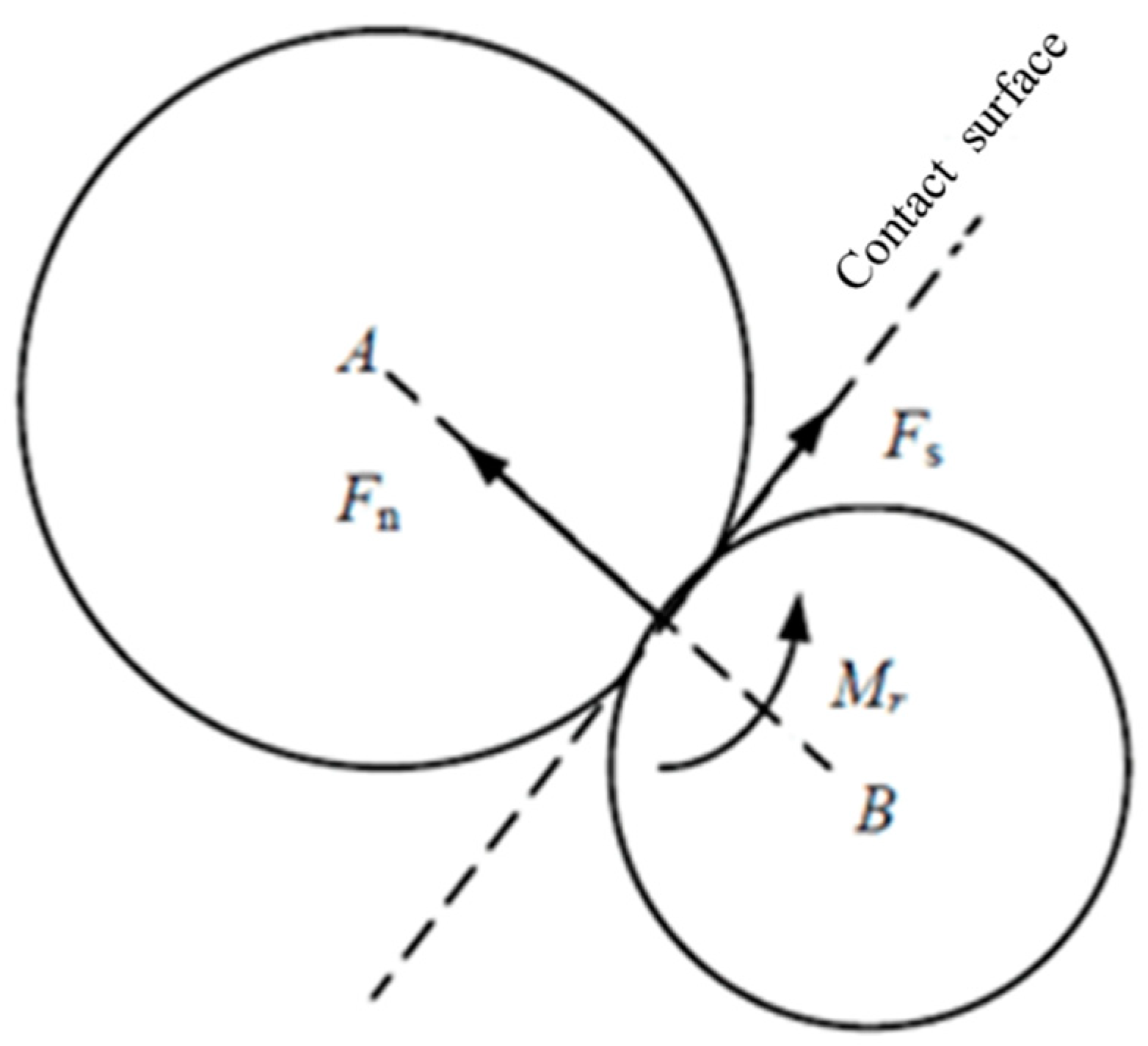
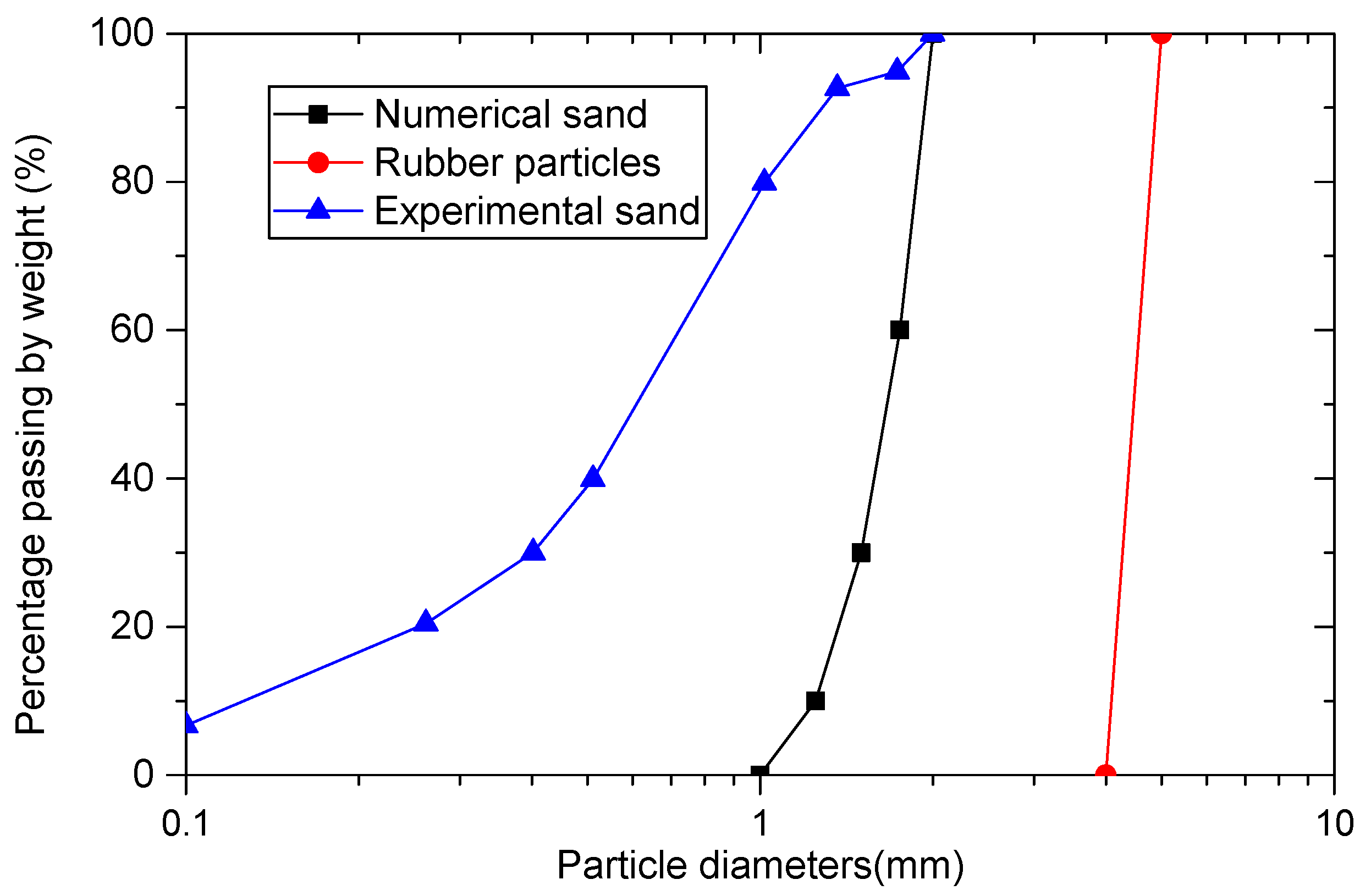
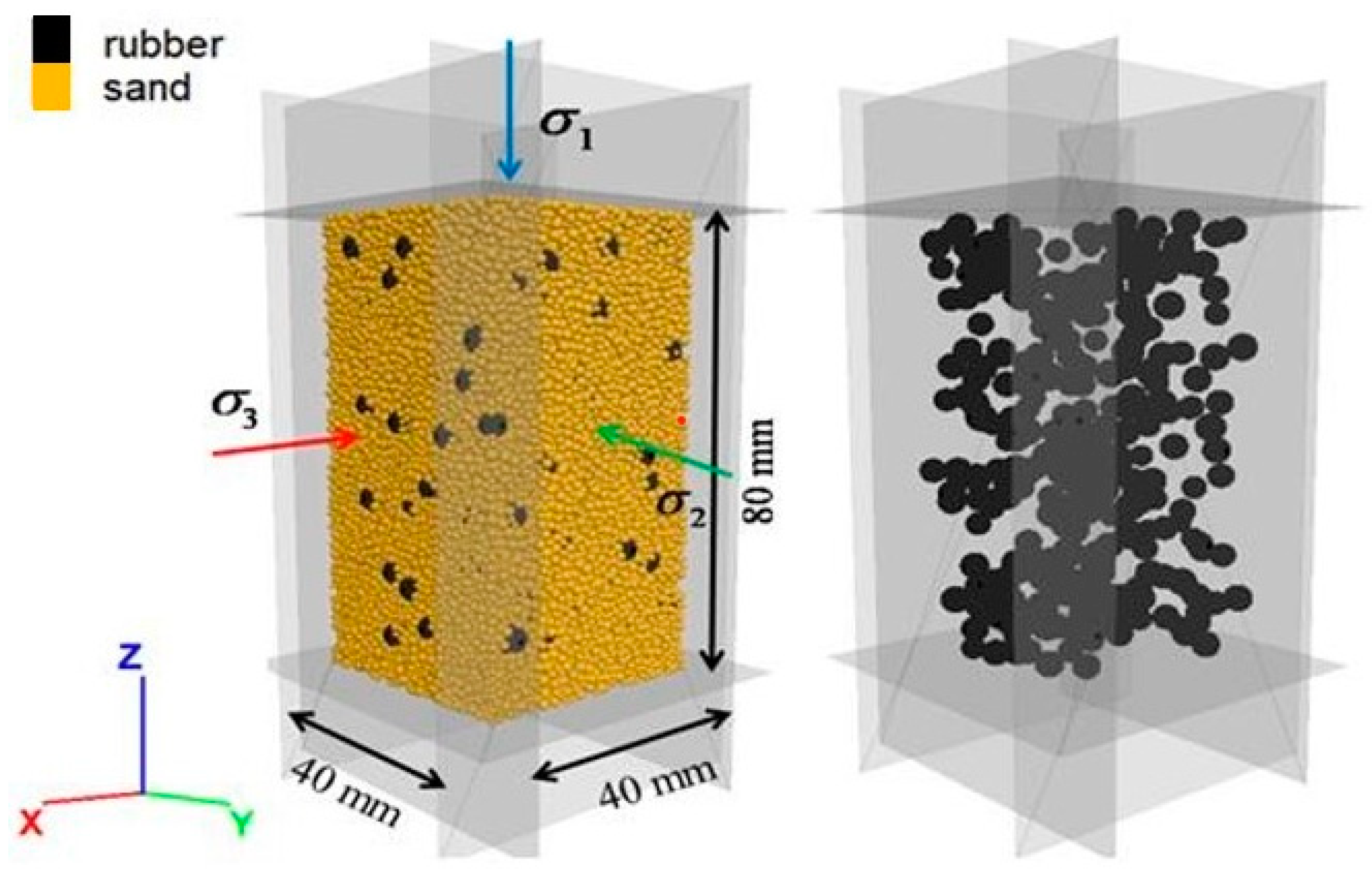
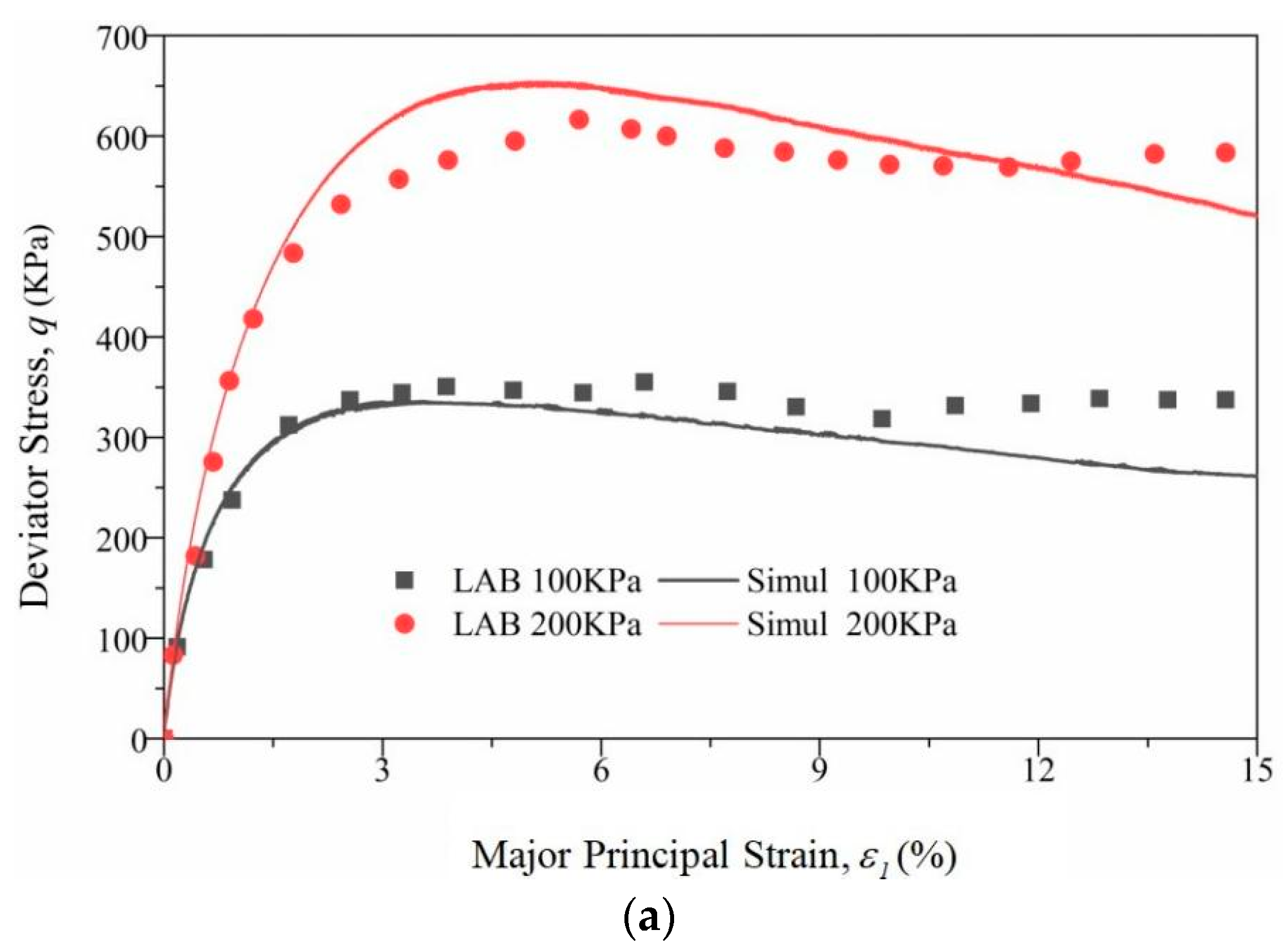
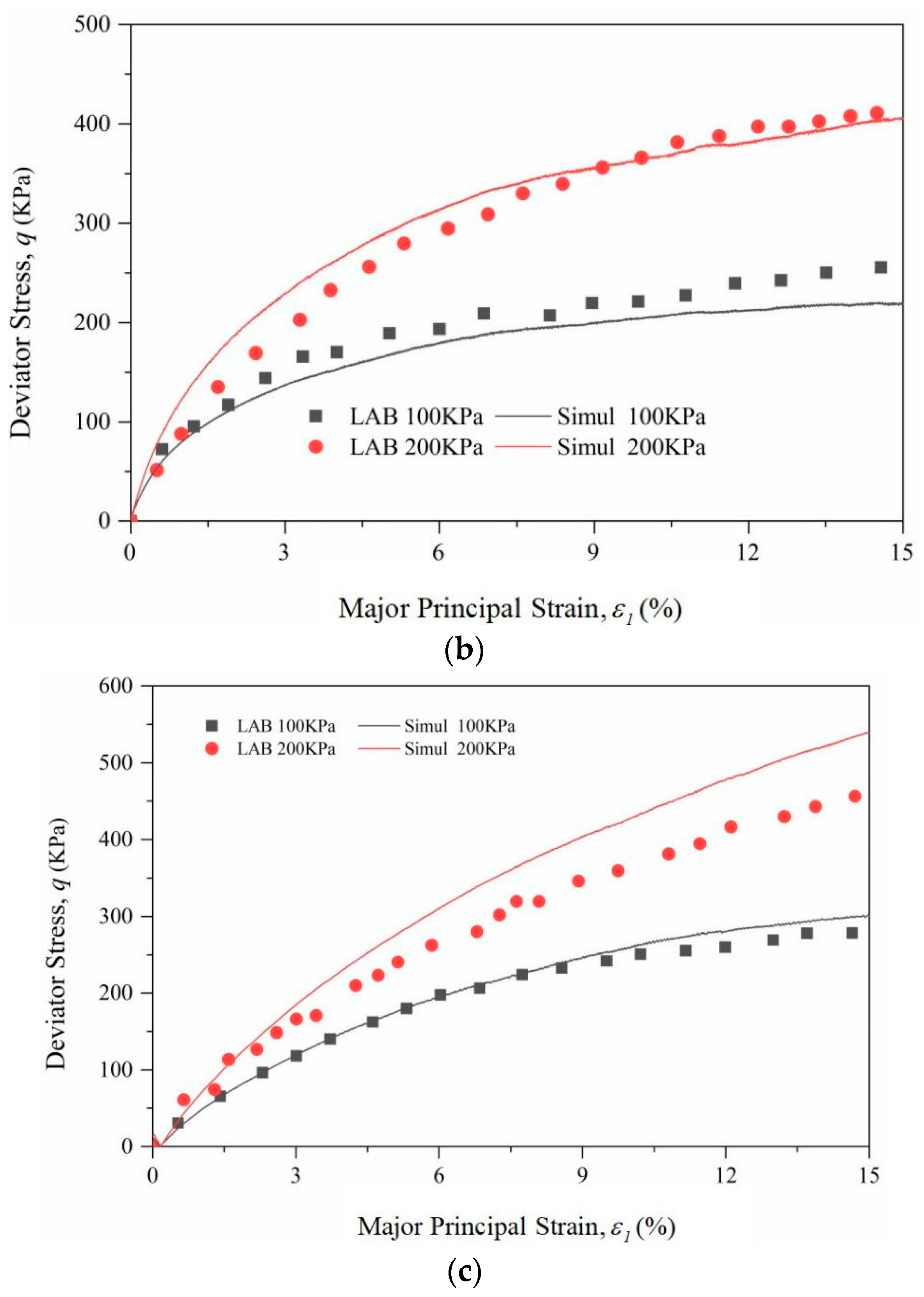
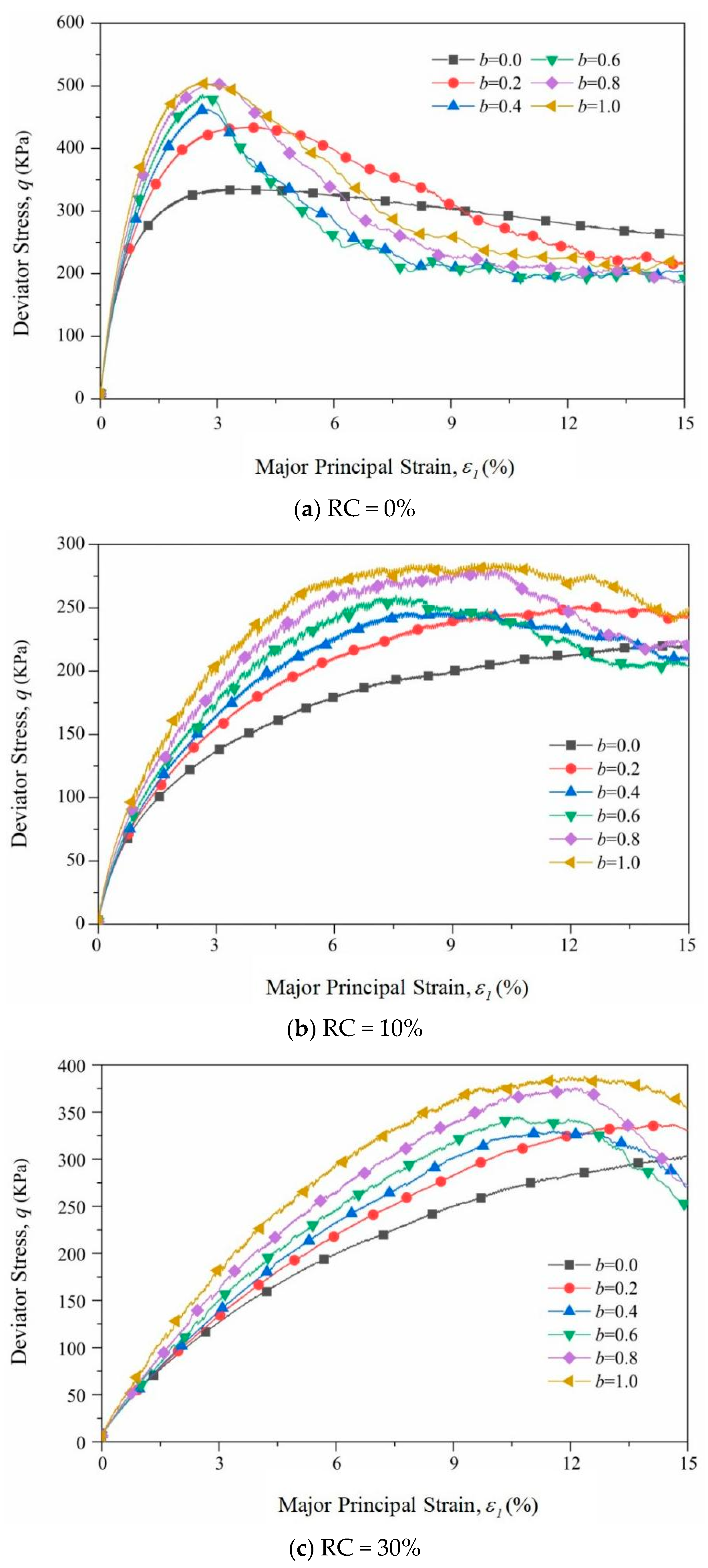




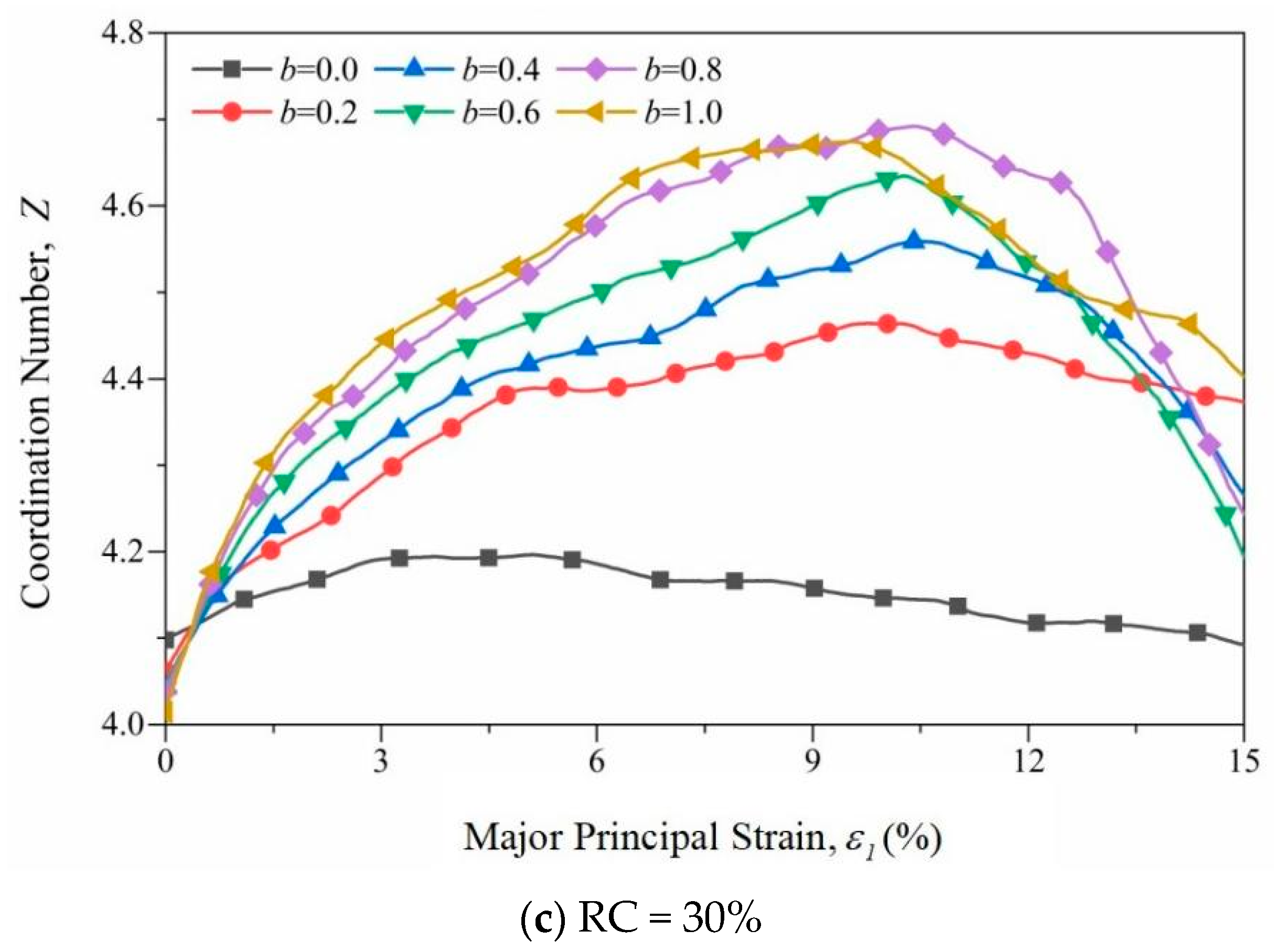

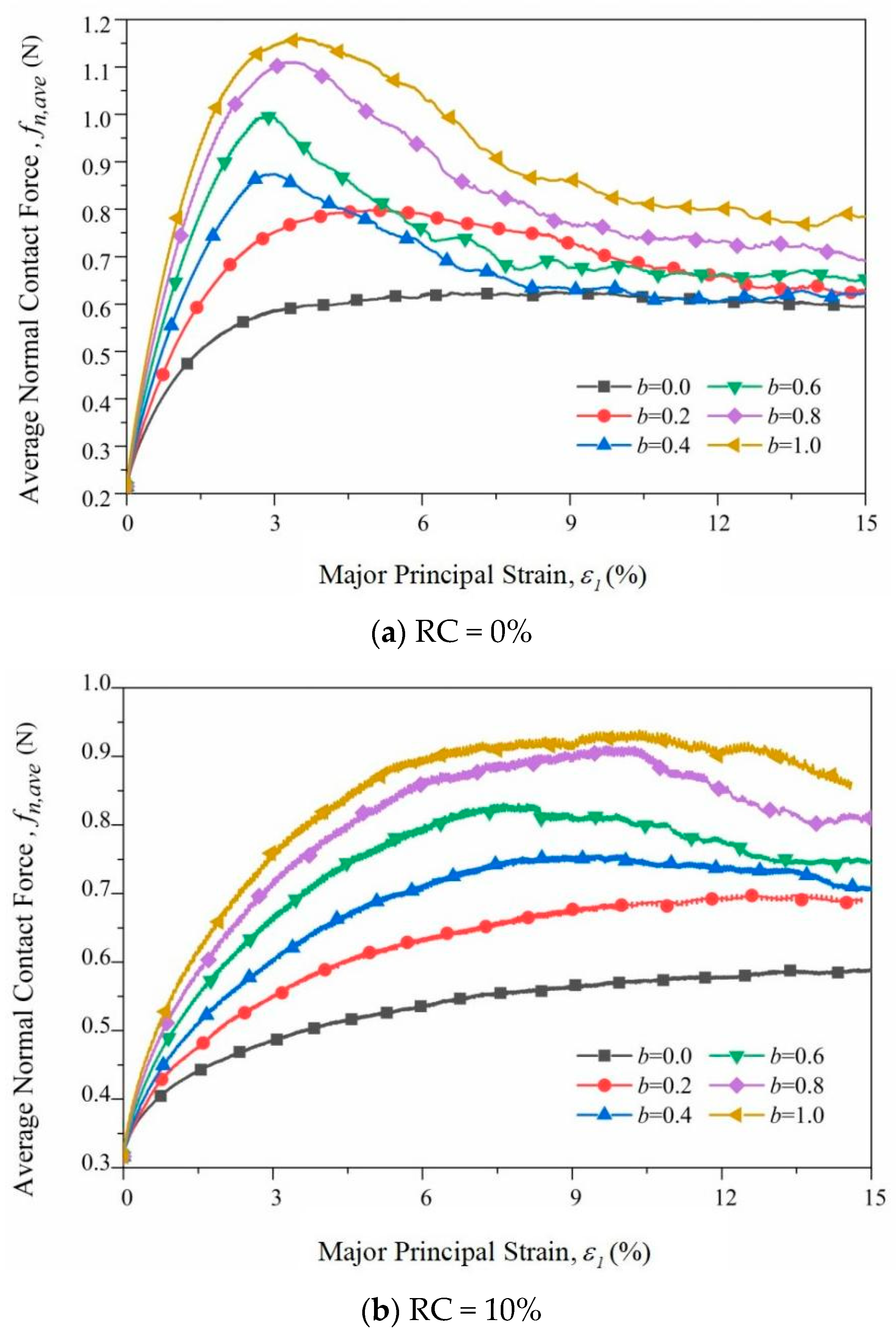
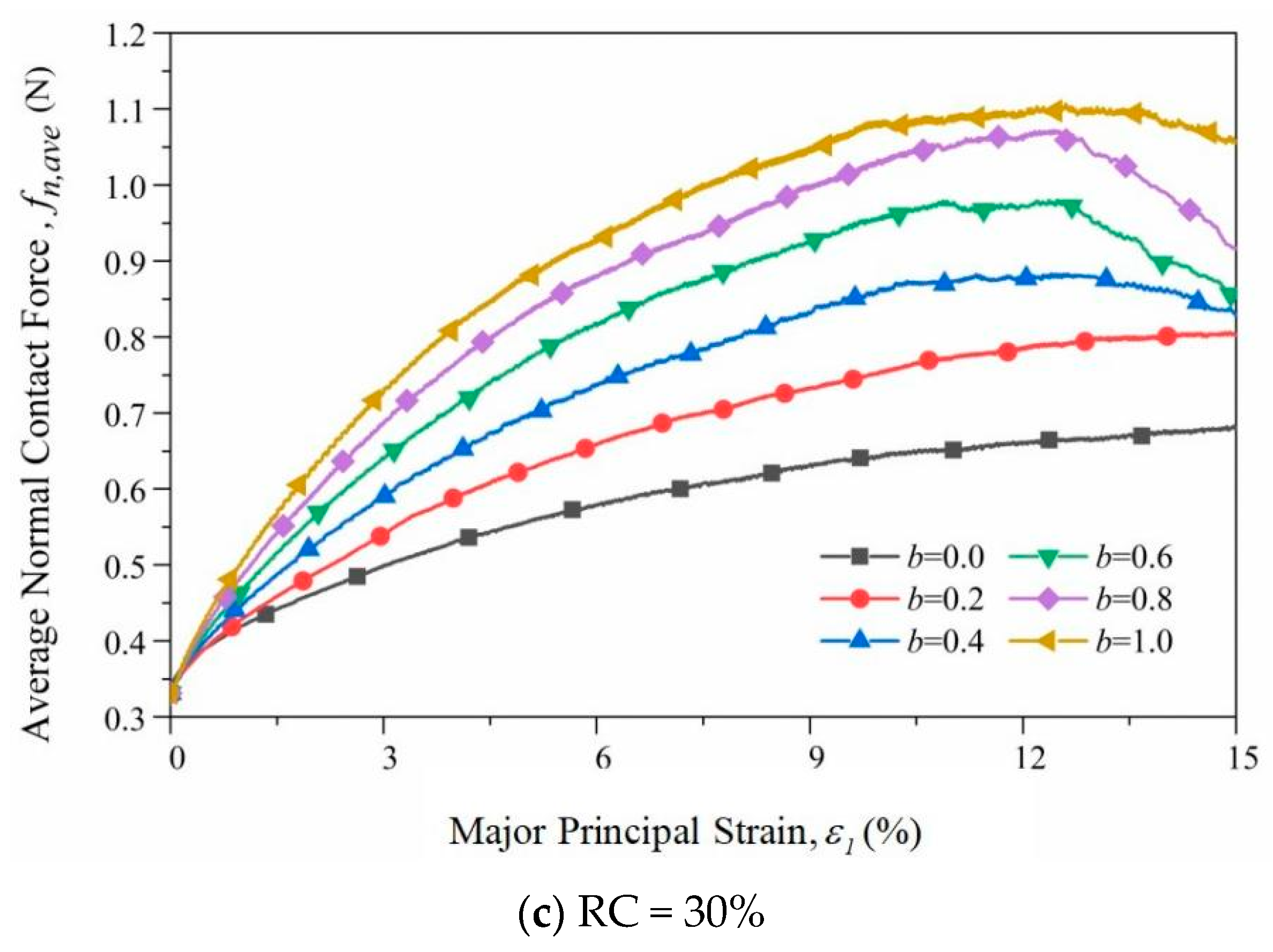

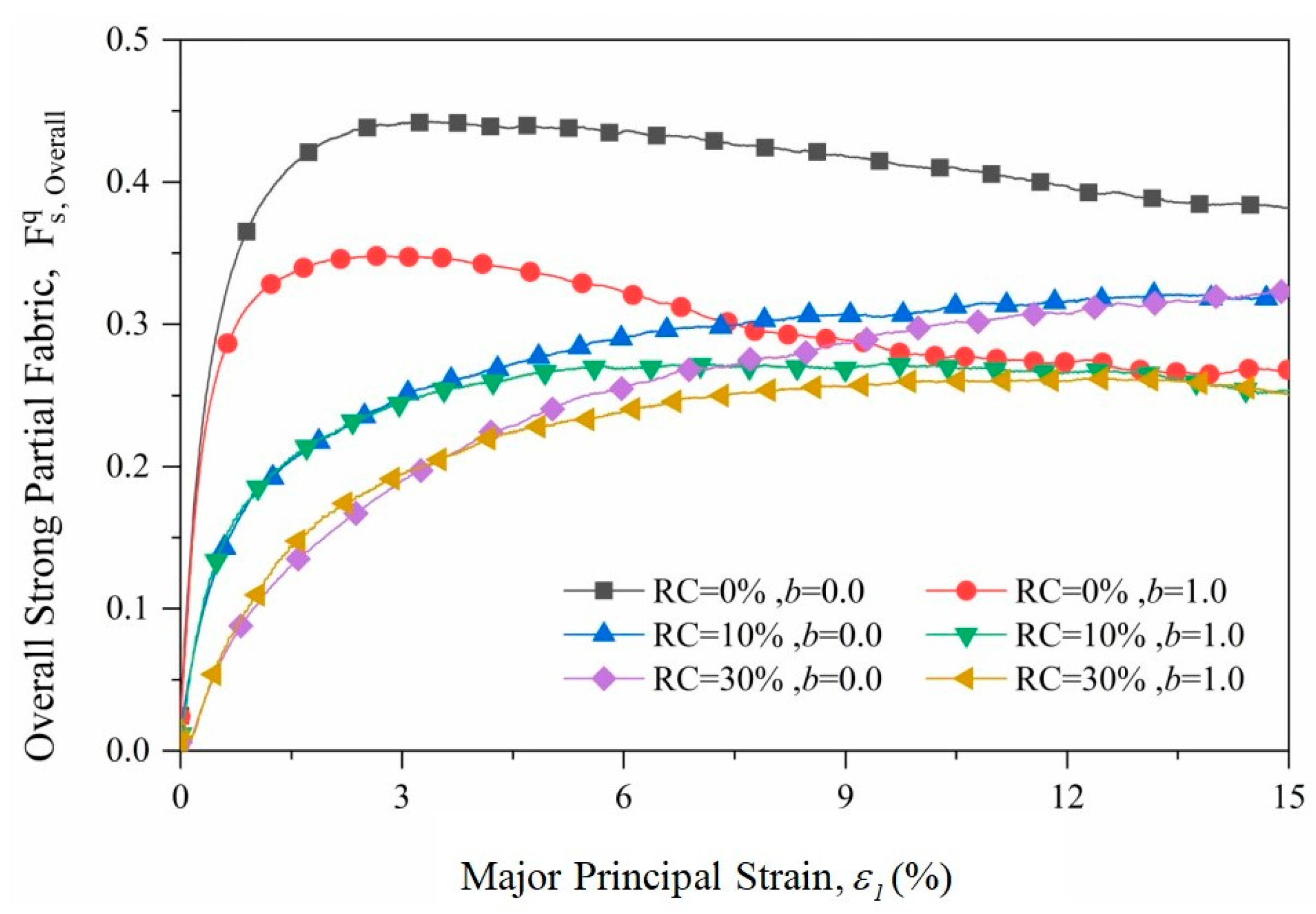
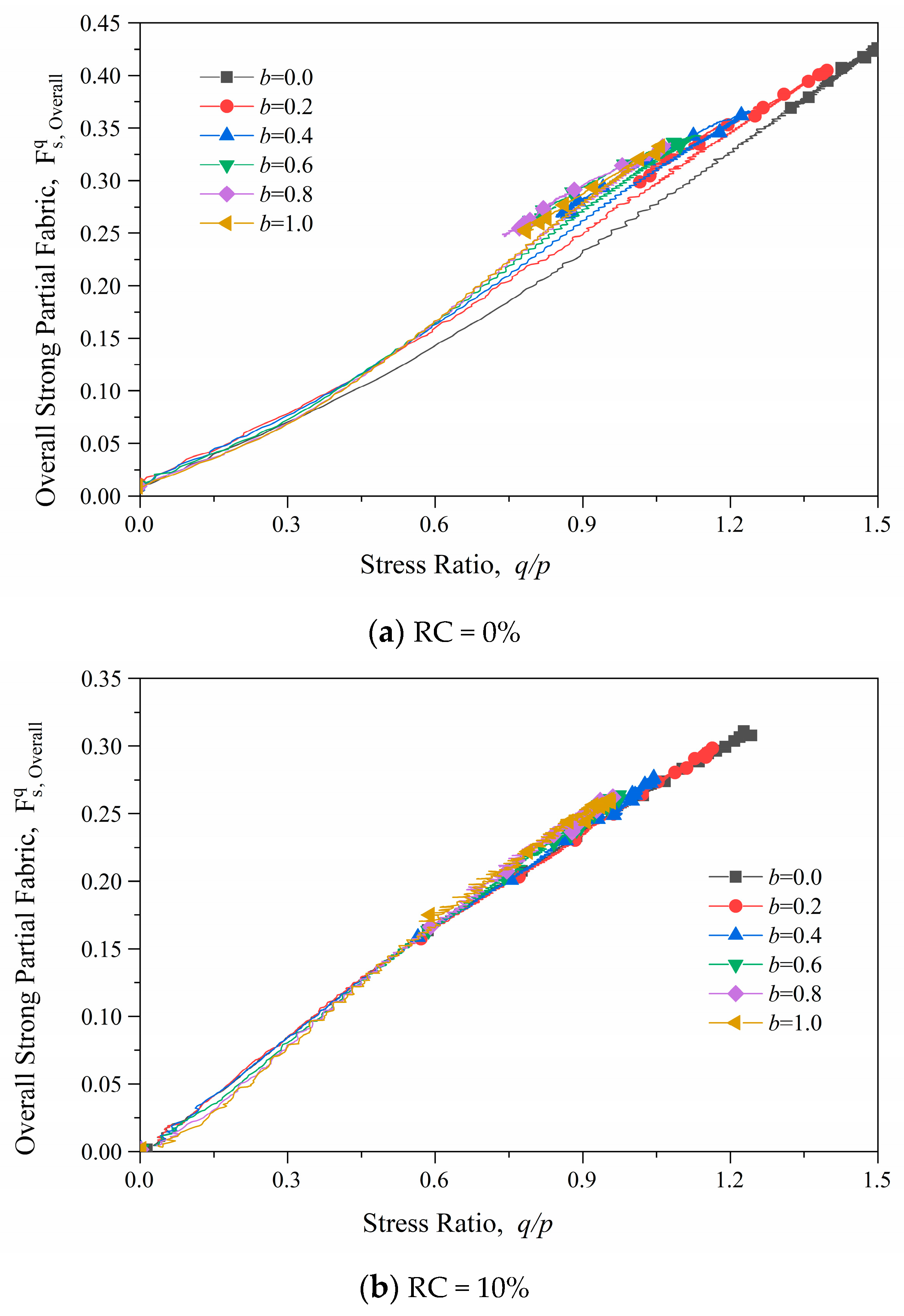

| Reference | 2D or 3D | Contact Constitutive Model | Normal Stiffness (Rubber/ Sand) | Tangential Stiffness (Rubber/ Sand) | Initial Shear Modulus (Rubber/ Sand) | Poisson’s Ratio (Rubber/ Sand) | Friction Coefficient (Rubber/Sand) | Rolling Resistance Coefficient (Rubber/Sand) |
|---|---|---|---|---|---|---|---|---|
| Liu et al. [28] | 2D | Linear | 1.5 × 105/1.5 × 108 | 1.5 × 105/1.5 × 108 | — | — | 1.0/0.5 | — |
| Wang et al. [29] | 3D | Linear | 8.0 × 105/5.9 × 107 | 8.0 × 105/5.9 × 107 | — | — | 0.60/0.55 | — |
| Perez et al. [17,18,19] | 3D | Hertz | — | — | 1.2 × 107/8 × 109 | 0.45/0.12 | 1.0/0.25 | — |
| Gong et al. [22] | 3D | Rolling resistance | 1.0 × 103/emod-8 × 107 | 1.0× 103/emod-8 × 107 | — | — | 1.5/0.25 | —/0.25 |
| Particle Type | Material Parameters | Value |
|---|---|---|
| Sand | Density | 2620 |
| Radius | 2~2.5 | |
| Number | 43,693, 34,909, 18,995 | |
| Damping | 0.7 | |
| Friction coefficient | 0.35 | |
| Rubber | Density | 1330 |
| rmin rmax/rmin | 0.5 2.0 | |
| Number | 0, 299, 631 | |
| Damping | 0.7 | |
| Friction coefficient | 1.0 |
| Contact Type | Micro-Parameters | Value |
|---|---|---|
| Sand–Sand | Effective modulus | 1.0 × 108 |
| Stiffness ratio | 1.0 | |
| Friction coefficient | 0.335 | |
| Rolling resistance coefficient | 0.35 | |
| Rubber–Rubber | Normal stiffness | 3.5 × 104 |
| Tangential stiffness | 3.5 × 104 | |
| Friction coefficient | 1.5 | |
| Rolling resistance coefficient | 1.0 | |
| Sand–Rubber | Effective modulus | 8.0 × 106 |
| Stiffness ratio | 1.0 | |
| Friction coefficient | 1.0 | |
| Rolling resistance coefficient | 0.5 | |
| Particle–Wall | Effective modulus | 1.0 × 108 |
| Stiffness ratio | 1.0 | |
| Friction coefficient | 0.0 |
Disclaimer/Publisher’s Note: The statements, opinions and data contained in all publications are solely those of the individual author(s) and contributor(s) and not of MDPI and/or the editor(s). MDPI and/or the editor(s) disclaim responsibility for any injury to people or property resulting from any ideas, methods, instructions or products referred to in the content. |
© 2024 by the authors. Licensee MDPI, Basel, Switzerland. This article is an open access article distributed under the terms and conditions of the Creative Commons Attribution (CC BY) license (https://creativecommons.org/licenses/by/4.0/).
Share and Cite
Liu, Y.; Gao, X.; Dou, H.; Yang, L.; Cao, Z. Numerical Study on the Mechanical Behavior of Sand–Rubber Mixtures under True Triaxial Tests. Appl. Sci. 2024, 14, 4560. https://doi.org/10.3390/app14114560
Liu Y, Gao X, Dou H, Yang L, Cao Z. Numerical Study on the Mechanical Behavior of Sand–Rubber Mixtures under True Triaxial Tests. Applied Sciences. 2024; 14(11):4560. https://doi.org/10.3390/app14114560
Chicago/Turabian StyleLiu, Yiming, Xiang Gao, Huiru Dou, Liu Yang, and Zhangshuaihang Cao. 2024. "Numerical Study on the Mechanical Behavior of Sand–Rubber Mixtures under True Triaxial Tests" Applied Sciences 14, no. 11: 4560. https://doi.org/10.3390/app14114560
APA StyleLiu, Y., Gao, X., Dou, H., Yang, L., & Cao, Z. (2024). Numerical Study on the Mechanical Behavior of Sand–Rubber Mixtures under True Triaxial Tests. Applied Sciences, 14(11), 4560. https://doi.org/10.3390/app14114560






